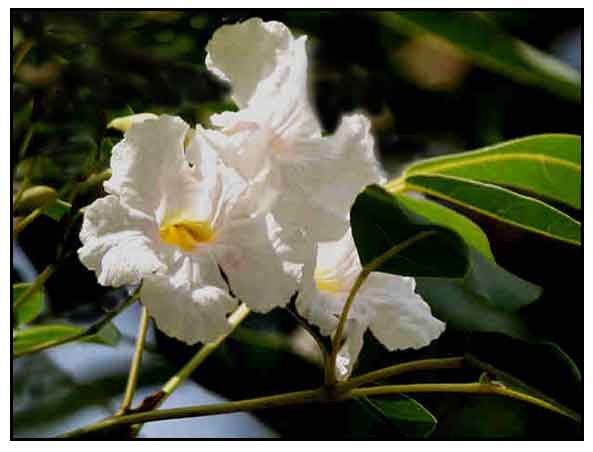|  Gen info Gen info
- Tabebuia is a genus of flowering plants in the family Bignoniaceae.
- Tabebuias have been called "trumpet trees", a commoname applied to many local trees and a source of confusion.
(see above)
Botany
Tabebula pallida is a tree growing to a height of 6 to 7 meters. Leaves are. opposite and palmately compound. Leaflets are obtuse, usually 1 to 3, sometimes 4 or 5, oblong or narrowly obovate, up to 10 centimeters long. Flowers are solitary to few, cymes up to 5 centimeters long. Corolla is lilac white with a yellow tube. Fruit is pendant, linear, capsule up to 25 centimeters long.
 Distribution Distribution
- Introduced to the Philippines.
- Cultivated as a showy flowering street tree.
- Wind-borne seed propagation.
Constituents
- In a study of various extracts of T. pallida, the ethyl acetate fraction (EAF) showed highest phenolic and flavonoid contents, 158.17 mg/g GAE and 5.43 mg/G CAE, respectively. (see study below) (3)
Properties
- Studies have suggested antibacterial, cytotoxic, antioxidant, free radical scavenging properties.
Parts utilized
Bark and leaves.
Uses
Folkloric
No recorded folkloric medicinal use in the Philippines.
In Antigua, bark of the tree used for corns and chopped leaves used for poultices.
Others
- Wood: Yields an excellent timber, used for making bowls, mortars and canoes.
Studies
• Antibacterial / Multi-Drug Resistant Bacteria / Flowers: Study evaluated crude extracts of leaves, stem bark, root bark, and flowers of Tabebuia pallida using disk diffusion and serial dilution method. Among test bacteria, E. coli was susceptible to all except the root extracts. The flower part was highly sensitive against all tested pathogens with maximum zone of inhibition of 21 mm. Results suggest the flower is a potential source of herbal medicines to treat infections. (2)
• Anticancer / Anti-ROS / Leaves: Study evaluated the in-vitro anti-ROS and in-vivo anticancer activities of Tabebuia pallida leaves against Ehrlich's ascites carcinoma (EAC) cells. Among the extracts, the ethyl acetate fraction (EAF) showed highest phenolic and flavonoid contents, 158.17 mg/g GAE and 5.43 mg/G CAE, respectively. The EAF showed highest total antioxidant capacity of 2.30 ± 0.080, and highest DPPH and hydroxyl radical scavenging activity with IC50 of 6 ± 0.25 µg/ml and 3.58 ± 0.28 µg/ml, respectively. The EAF also showed potent inhibitory activity against lipid peroxidation with IC50 of 14.33 ± 0.14 µg/ml. The in-vitro cytotoxic and in-vivo anticancer activity was evaluated against brine shrimp nauplii and EAC-induced tumor-bearing mice. EAF also showed moderate cytotoxic effect with ED50 of 8.50 ± 0.70 µg/ml and significant cell growth inhibition. (3)
• Antioxidant / Free Radical Scavenging Activity / Leaves: Study evaluated the antioxidant and free radical scavenging properties of methanolic extracts of T. pallida stem bark, root bark, leaves and flowers. Leaves (TPL) extract showed the highest total antioxidant capacity. Based on DPPH and hydroxyl radical scavenging activity, TPL showed strong scavenging activity (91.05± 1.10 and 62.00 ± 0.57 with IC50 of 9.20 ± 0.28 and 46.00 ± 2.84 µg/ml, respectively. In lipid peroxidation inhibition assay, TPL also showed most potent inhibitory activity with 83.18 ± 2.12% and IC50 of 12.00 ± 2.12 µg/ml. Results suggest a potential plant based pharmaceutical product for diseases caused by free radicals. (4)
Availability
- Wildcrafted.
-
Cultivated.
|







